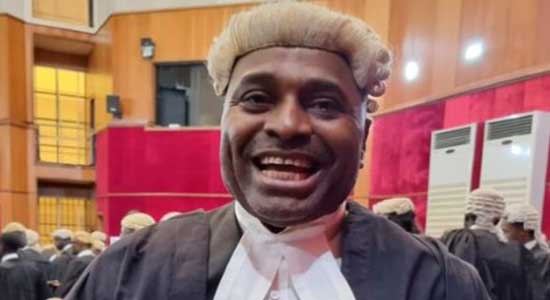Collapsed Buildings And Insurance: Protecting The Innocent

By Dr. Muiz Banire SAN
In recent times, there has been incessant incidence of building collapse across the country. The extent to which this menace has become a pattern tends to suggest that it is a new normal. The situation is so deplorable and despicable that the usual attendant uproar and expression of discontent that greets such misfortunes is fast vanishing from our environment. Quite apart from the huge material losses incurred in the process, several lives get lost, while many are maimed.
There is no doubt that this alarming situation demands attention from the appropriate authorities. The country needs to minimize, if not curb, this catastrophe before we all directly or indirectly become casualties. While it is generally true that in most of the instances of building collapse the developers of those properties are primarily liable, the relevant public authorities cannot, however, be exempted from blame.
I have in a past edition of this column addressed extensively factors responsible for housing collapses, which range from the use of poor and substandard building materials, incompetent builders, inadequate or non-supervision, non-adherence to building codes and approved designs, over-development of structures, etc ( See my column in the Daily Sun of 21st April 2022 “Time to hold government accountable [Part 2]” https://www.sunnewsonline.com/time-to-hold-government-accountable-2 ).
As this is not my destination, I apply the brakes here. In all of the catastrophes, the government, especially at the state level, that controls physical planning and urban development, particularly development permits, is most culpable. Apart from being responsible for the master plan of their respective cities, the state governments presumably issue development permits for all the developments in the various states. By way of corresponding responsibility, therefore, the state governments are under obligation to monitor the developments and enforce the provisions of the physical planning laws vis-a-vis adherence or compliance with the permits issued. The extent to which state governments have carried out this responsibility is attested to by the multitudes of building collapses witnessed regularly.
There have been so many lapses and impunity in the enthronement of order in the physical and urban planning space to the extent that the blind can even feel it. Let me start by saying that most of the developments that go on in most states of the federation lack the pre-requisite development permits, and where they manage to acquire such development permits, they are hardly complied with. In no more than 50 percent of the developments in the states would you find approved development permits. Although there are regulatory organs of government responsible for the abatement of such aberrations, they are unimpactful largely due to compromise and corruption. Again, lack of proper evaluation of the submitted drawings such as architectural, mechanical and electrical, is a factor equally militating against the survival of some of the structures/buildings.
Besides the incompetence of some of the officials responsible for the evaluation, corruption has eaten deep into the arena to the extent that where inadequacy is detected in the drawings, they are often overlooked. This is the foundation of the eventual calamities that occur. Where, even in the exceptional circumstances, proper development permits are issued, monitoring of the development is compromised. In a sizeable number of building collapses, it has been uncovered that it is either no development permits exist or that development permits were circumvented. Outside these basic areas is the quality of the building materials used. These range from poor sand, cement, inferior/substandard iron rods, wrong mix, etc. To address this challenge, both at the national and sub-national levels, there are agencies responsible for the guarantee of the quality of the materials to be used in building. On one hand is the agency like the Standard Organization of Nigeria at the federal level, and bodies at the State level charged with the testing and ascertainment of the quality of the materials.
In Lagos State for instance, there exists the material testing laboratory that conducts such tests and certifies the materials. Securing compliance in this respect still remains a challenge. Towards ensuring compliance with what has been approved in the development permits, other agencies with different nomenclatures exist across the country. However, as characteristic of the personnel, one hardly finds integrity in their operations. There is abundant story of non-compliance with such approved drawings. By the Lagos State Building Controls Law, there is stage certification to be carried out to ensure not only compliance with the approved developments but also adherence to the quality of materials. Beyond all these, there are several expected monitoring to be done, part of which, in accordance with the law, if the structure under construction is above two floors, the development must be insured. With all the above safeguards, if adhered to, the expectation would be that the country experiences minimal or less building collapses. I certainly need not tell you that the converse is the situation in the country. Again, the inefficiency, or if you prefer, impotency of the regulatory authorities is not really the focus of this intervention but a prelude.
The crux of the engagement centres on the consequence, and the mitigation of the highly probable risk in contemporary times. As deducible from the above discussion, in most of the situations that we have building collapses, there is hardly any instance in which the victims get compensation from any quarters. Ordinarily, what ought to be established first is the culpability of any of the parties, the developer, the independent contractor or the insurance company, where any. From the analysis earlier, where everything is done and there is proper monitoring of the development, devoid of negligence, and a building collapse, the expectation is that the developer and/or the independent contractor ought to be held accountable, in which event, pay compensation to the victims, or their relatives where the consequence is fatal. As it often happens, this class of people hardly has the means or capacity to give effect to the compensation.
This probably explains why the insurance law says that where buildings of two floors and above are under construction, such must be compulsorily insured. In my view, the insurance in this case ought to be comprehensive enough to accommodate not only workers on site but all legitimate visitors to the premises as at the time of collapse. More often than not, unlike in other jurisdictions, potential off-takers taken for inspection at the site becomes causalities. Regrettably, in over ninety percent of the developments we witness, you hardly see such insurance compliance, and where it exists, it is either inadequate or fake. Nobody checks or cares, or naturally, the process is compromised. As I said earlier, government is expected to ensure compliance in all the instances painted above but again, the government is ever found wanting in terms of dereliction. In such situations, one would have expected that the government and by extension, the regulatory authority should have felt ashamed when a building collapses, but alas! that is never so. Rather than assuming liability and shouldering the responsibility of compensating the victims, government rather regales in confiscating the remnant property for the State.
Even if that is to be done, my expectation is that the sum derivable from the value of the property directly or indirectly should have been applied to compensate the victims. NO. The government appropriates all. This, in my humble view, is totally unfair, if not wicked.
Now, where the government knows that it is incompetent to administer the laws effectively, the least it can do is to ensure that the compensatory structure or mechanism is, at worst, in place. This would have been consolation to the public for the ineptitude of the government. The message is, therefore, if there is any building collapse which claims an innocent victim like a third party, the government must be made liable and accountable. It is when the public starts holding the government accountable that the government will become alive and alert to its responsibility, at least, in enforcing the pre-requisite of insurance in building construction.
As the law stands today, it will appear that the only mandatory insurance of property, outside the insurance of public buildings, is that of properties of two floors and above under construction. For fully constructed buildings, insurance is an optional thing at the discretion of the developer or owner. As painted earlier, majority of these completed and inhabited buildings are, however, defective structures that do not only endanger the inhabitants but visitors to the buildings. The import of the law today is that such buildings need not be insured except the owner/developer so desires. The implication of this is that in the event of any mishap such as frequently witnessed in contemporary times, nobody is under obligation to compensate the innocent victims. My advocacy, therefore, is that the insurance legislation needs to be urgently overhauled and amended to cover all structures/buildings, regardless of the completion status or floors. Until this amendment is effected, it is my view that we have to keep on holding the government culpable and accountable to the third party innocent victims.
This is simply because it is the government that is duty bound to ensure compliance with the development laws in all ramifications. So, where government has chosen to be negligent and derelict in this regard, the government must pay. It is when we start forcing this accountability that the government will wake up from its slumber by also holding the involved government officials accountable. In my further opinion, where death occurs as a result of any building collapse traceable to the negligent or compromise of government officials, such officials must be arraigned for murder, or at the barest minimum, manslaughter. It is when this starts happening that government staff in charge of building monitoring will take themselves seriously.
This same principle needs to be extended to other areas of negligence in the discharge of public duties. This is reawakening period and must be so treated. In all, my submission is that the insurance of buildings, either under construction or thereafter needs not only be legally compulsory but must be enforced in order to secure the collective interest of all. This is a duty that devolves on the government, failing which the government must pay the price and be made to bear the brunt of all damage suffered by innocent victims. A stich in time, saves nine!



